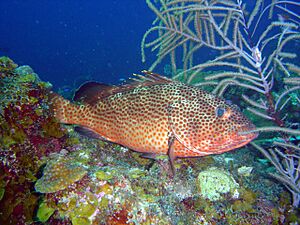Red hind facts for kids
The red hind (Epinephelus guttatus) is a cool fish that lives in the ocean! People sometimes call it the koon or lucky grouper in the Caribbean. It's a kind of grouper, which belongs to a big fish family called Serranidae. This family also includes other fish like sea basses. You can find the red hind in the western part of the Atlantic Ocean, all the way from the eastern United States down to Brazil. It's actually the most common type of Epinephelus fish you'll see in the Caribbean Sea.
Quick facts for kids Red hind |
|
|---|---|
 |
|
| Conservation status | |
| Scientific classification | |
| Synonyms | |
|
Contents
What Does the Red Hind Look Like?
The red hind has a strong body that's a bit flat on the sides. It's deepest near its dorsal fin (the fin on its back). Its gill cover has three flat spines. The edge of its cheek plate (preopercle) is slightly bumpy.
The dorsal fin has 11 stiff spines and 15 or 16 soft rays. The anal fin (underneath the body) has 3 spines and 8 soft rays. Its tail is slightly rounded.
This fish is usually greenish-grey or light brown on top. Its belly is white. It has many orange-red or brown spots all over its head, body, and fins. You might also see five faint, slanted stripes made of darker spots on its sides.
Red hinds can grow up to about 76 centimeters (30 inches) long. But they are usually around 40 centimeters (16 inches). The heaviest one ever recorded weighed about 22 kilograms (48 pounds)!
Where Do Red Hinds Live?
The red hind lives in the Western Atlantic Ocean. You can find them from Bermuda and North Carolina down the eastern coast of the United States. They also live in the Gulf of Mexico and all over the Caribbean Sea. Some people say they live as far south as Brazil. However, there are no confirmed sightings south of Venezuela.
Habitat and Diet
Red hinds like to live in coral reefs and on rocky ocean floors. Female red hinds usually stay close to the bottom. Male red hinds swim around and protect their territory from other males. A male's territory can overlap with the areas where one to five females live.
These fish eat a variety of things. Crabs are their favorite food! They also enjoy eating mantis shrimp, which make up a big part of their diet. Other fish they eat include Bluehead Wrasse, Boga, goatfishes, and small moray eels. They especially love shrimps and octopuses.
Red Hind Life Cycle
Red hinds are special because they are "protogynous hermaphrodites." This means they start their lives as females and then change into males later on! Scientists don't fully understand what makes this change happen.
In places like Puerto Rico, red hinds gather together to lay their eggs. This happens in specific spots along the ocean shelf. They usually do this for one to two weeks during January and February, following the moon's cycles. In 1992, a tagged red hind traveled over 16 kilometers (10 miles) to reach a special spawning site. It even swam over deep water and passed other groups of fish to get there!
We don't know much about baby red hinds. But sometimes, tiny young fish, about 2.5 to 5 centimeters (1 to 2 inches) long, are seen hiding near reefs in moderately deep water. Most adult red hinds live for about ten to eleven years.
How Red Hinds Got Their Name
The red hind was first officially described in 1758. A famous scientist named Carolus Linnaeus gave it the scientific name Perca guttata in his book Systema Naturae.
Why Red Hinds Are Important
The red hind is a very important fish for fishing in the Caribbean. Many of them are caught, and they weigh a lot! People catch them using spears, hooks and lines, and traps.
This fish is considered a delicious food. Mexico even exports red hinds to the United States. It's also a popular fish for people who enjoy recreational fishing.


